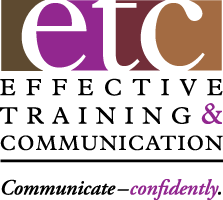Do you ever experience pain in creating and delivering important workplace presentations? Do your audiences experience pain listening to those presentations? If you answered ‘yes’, read on for a brief overview of Presentation Best Practices. They can help you present with more confidence … and less pain for you and for them.
10 Simple-But-Not-Easy Best Practices
- Audience-Centricity – everything you say and do is for your audience and the objectives that brought you together. It’s not about you.
- ‘Main Point’ – the single reason you’re talking to them. It’s not your topic or title, but a simple phrase that says it all. For instance, ‘The 2012 Product Show provides more choices for less cost’ is a Main Point. It should be in your introduction, conclusion and throughout your content.
- ‘Sub Points’ – instead of saying you have five topics to discuss, indicate you have only one topic instead, your Main Point. Convert those five points into its connected Sub Points.
- Audience-Centric Language – limit technical jargon or acronyms as much as possible. Without condescending, use simple conversational language your audience likely uses and will be comfortable with hearing. Sound like people talking to people.
- Targeted Audiences – strive for more homogeneous audiences where possible. It’s hard to focus your message if you’re talking to hourly people, managers and executives at the same time. Divide and Conquer.
- Audience Analysis – thoroughly analyze the demographics of your audience. The more you know about them, the better you can meet their needs. Also consider their ‘psychographics’ – attitudes, mindsets, objections, feelings and values that can influence their reaction to your message.
- Clear Organization – make it very easy for them to follow the flow of your content. Use transitional phrases or ‘guide posts’ to indicate changes in Sub-Points.
- Death-By-PowerPoint – just because you have it doesn’t mean you should use it. Create effective, easy-to-read slides that add value to your message and audience. Less is more. Bigger is better. Avoid cute transitions or sound effects. And never read your slides to them.
- Vocal Energy – deliver your message with enthusiasm, energy and a comfortable pace. You may have delivered it 10 times, but each audience only hears it once. So, speak up and slow down.
- Physical Energy – project confidence and credibility with sustained eye contact, effective gestures and a winning smile. Look like you belong up there and are having fun.
Like I said up front, these Best Practices are simple to understand but not easy to do. They take time and lots of practice to master. But, if you want to take the pain out of workplace presentations for you and your audiences, they really work and are worth the effort.

Phil, great advice in this article. Simple-but-not-easy for sure, but absolutely critical. I’ve trained over 1,000 people on communication and presentations; your comments in this article are the most on-point and relevant I’ve seen in a single post. Well done.
DJA
David, thanks so much for your kind comments about my latest article. I appreciate your feedback, especially coming from someone like you with such terrific credentials in workplace presentations.
Stay tuned for more … Phil